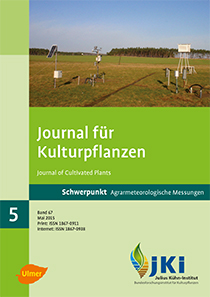Trial field Dahnsdorf – 15 years of agrometeorological measurements Part 1: General
Keywords:
Trial field, precipitation, normal value, temperature, vegetationAbstract
In 1998, an agrometeorological station was established at the trial field of the Julius Kühn-Institut (JKI), Federal Research Centre for Cultivated Plants, in Dahnsdorf. It allows to measure and analyze weather data which have an effect on the growth and development of plants and, thus, to identify interactions between agriculture and weather. The agrometeorological station was located close to numerous scientific agricultural long-term field trials.
An almost complete dataset of the most important meteorological elements was acquired for the 15 years from between 1998 and 2012. They are illustrated in several parts based on different statistical parameters and timescales and compared with long-term values of the climate normal period 1961/90 published by German Weather Service (DWD).
The first part (General) describes measuring and assessment methods and presents the results of the aggregate period (1998 to 2012) and the individual years. Furthermore, statements about the used normal values and the beginning and end of the growing season are discussed.
Compared to the normal period 1961/90, all years, with the exception of 2010, were warmer and twelve of the 15 years were more humid. The annual mean air temperatures ranged between 7.8°C in 2010 and 10.2°C in 2008 (normal value: 8.7°C). The annual sums of precipitation ranged between 392.4 mm in 2003 and 786.7 mm in 2007 (normal value: 509.3 mm). The considered period (from 1998 to 2012) had more summer days (max. ≥ 25.0°C) and hot days (max. ≥ 30.0°C) as well as less freezing days (min. < 0.0°C) and ice days (max. < 0.0°C) recorded. The number of days with precipitation ≥ 10.0 mm compared to the normal values increased by 38%.
The comparison with actual normal values bears some problems: On the one hand the current normal period (1961/90) is too distant from the considered period, on the other hand it is not always possible to use the nearest station.
Various methods are used to determine the beginning and end of the growing season. They may produce considerable differences. In 2003, for instance, the beginning of the growing season varies by about 75 days depending on the method.
At the trial field in Dahnsdorf, the beginning of the growing season varied depending on the used method between January 3rd (2007) and March 27th (1998), the end of the growing season between October 16th (2003) and December 23rd (2006).
DOI: 10.5073/JfK.2015.05.01, https://doi.org/10.5073/JfK.2015.05.01
Downloads
Published
Issue
Section
License
The content of the journal is licensed under the Creative Commons Attribution 4.0 License. Any user is free to share and adapt (remix, transform, build upon) the content as long as the original publication is attributed (authors, title, year, journal, issue, pages).
The copyright of the published work remains with the authors. The authors grant the Journal of Cultivated Plants, the Julius Kühn-Institut and the OpenAgrar repository the non-exclusive right to distribute and exploit the work.







